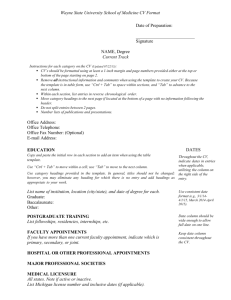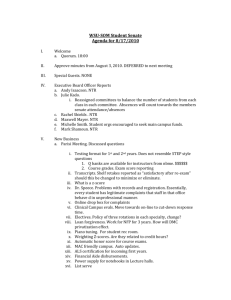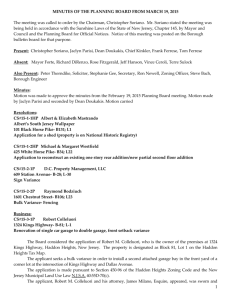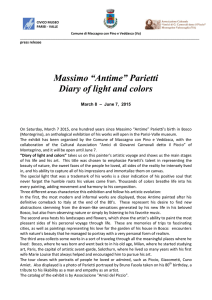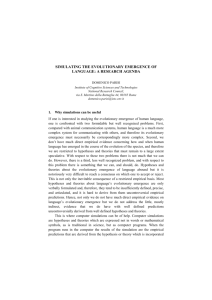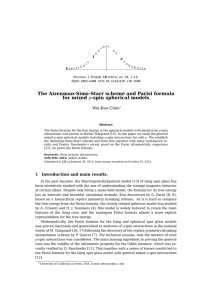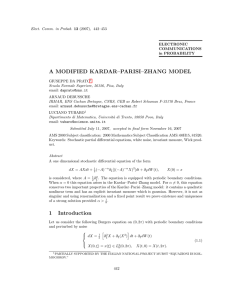ON DIFFERENTIABILITY OF THE PARISI FORMULA
advertisement
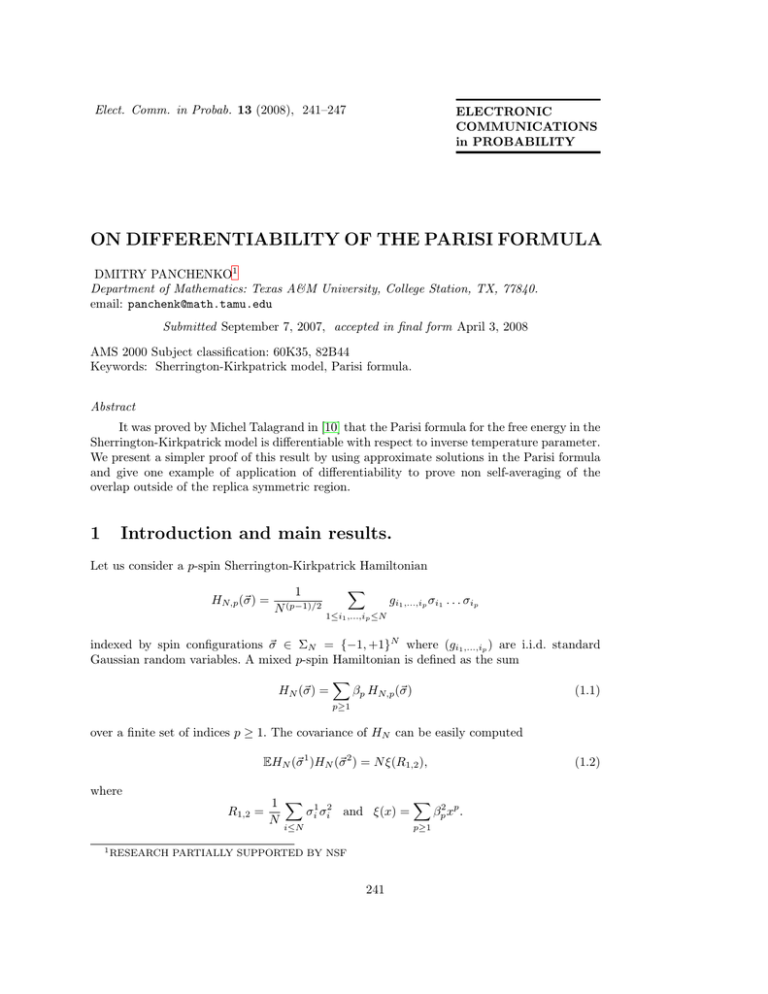
Elect. Comm. in Probab. 13 (2008), 241–247
ELECTRONIC
COMMUNICATIONS
in PROBABILITY
ON DIFFERENTIABILITY OF THE PARISI FORMULA
DMITRY PANCHENKO1
Department of Mathematics: Texas A&M University, College Station, TX, 77840.
email: panchenk@math.tamu.edu
Submitted September 7, 2007, accepted in final form April 3, 2008
AMS 2000 Subject classification: 60K35, 82B44
Keywords: Sherrington-Kirkpatrick model, Parisi formula.
Abstract
It was proved by Michel Talagrand in [10] that the Parisi formula for the free energy in the
Sherrington-Kirkpatrick model is differentiable with respect to inverse temperature parameter.
We present a simpler proof of this result by using approximate solutions in the Parisi formula
and give one example of application of differentiability to prove non self-averaging of the
overlap outside of the replica symmetric region.
1
Introduction and main results.
Let us consider a p-spin Sherrington-Kirkpatrick Hamiltonian
HN,p (~σ ) =
1
N (p−1)/2
X
gi1 ,...,ip σi1 . . . σip
1≤i1 ,...,ip ≤N
indexed by spin configurations ~σ ∈ ΣN = {−1, +1}N where (gi1 ,...,ip ) are i.i.d. standard
Gaussian random variables. A mixed p-spin Hamiltonian is defined as the sum
HN (~σ ) =
X
βp HN,p (~σ )
(1.1)
p≥1
over a finite set of indices p ≥ 1. The covariance of HN can be easily computed
EHN (~σ 1 )HN (~σ 2 ) = N ξ(R1,2 ),
where
R1,2 =
X
1 X 1 2
σi σi and ξ(x) =
βp2 xp .
N
i≤N
1 RESEARCH
p≥1
PARTIALLY SUPPORTED BY NSF
241
(1.2)
242
Electronic Communications in Probability
A quantity R1,2 is called the overlap of configurations ~σ 1 , ~σ 2 . To avoid the trivial case when all
the spins decouple we assume that βp 6= 0 for at least one p ≥ 2 so that ξ ′′ (x) > 0 for x > 0.
Given an external field parameter h ∈ R, the free energy is defined by
X
X ¢
¡
~ = 1 E log
exp HN (~σ ) + h
σi .
FN (β)
N
(1.3)
i≤N
~
σ
The problem of computing the thermodynamic limit of the free energy limN →∞ FN is one of
the central questions in the analysis of the SK model and the value of this limit was predicted
by Giorgio Parisi in [5] as a part of his celebrated theory that goes far beyond the computation
of the free energy. The prediction of Parisi was confirmed with mathematical rigor by Michel
Talagrand in [11] following a breakthrough of Francesco Guerra in [2] where a replica symmetry breaking interpolation was introduced. Validity of the Parisi formula provides a lot of
information about the model and, in particular, about the distribution of the overlap under the
Gibbs measure corresponding to the Hamiltonian HN (~σ ). In the next section we will show one
important application of the Parisi formula which is based on its differentiability with respect
to inverse temperature parameters. Namely, we will prove a stronger version of the result of
Pastur and Shcherbina in [6] about the non self-averaging of the overlap at low temperature.
In the remainder of this section we present a simplified version of the argument of Talagrand in [10] and prove the differentiability of the Parisi formula. Let us start by recalling the
definition of the Parisi formula. Let M be the set of cumulative distribution functions on [0, 1].
We will identify a c.d.f. m with a distribution it defines and simply call m itself a distribution
on [0, 1]. A distribution with at most k atoms is defined by
m(q) =
X
0≤l≤k
ml I(ql ≤ q < ql+1 )
(1.4)
for some sequences
0 = m0 ≤ m1 ≤ . . . ≤ mk−1 ≤ mk = 1,
0 = q0 ≤ q1 ≤ . . . ≤ qk ≤ qk+1 = 1.
Consider independent Gaussian r.v. (zl )0≤l≤k such that Ezl2 = ξ ′ (ql+1 ) − ξ ′ (ql ). Let
³ X
´
Xk = log ch
zl + h
0≤l≤k
and recursively for 1 ≤ l ≤ k define
Xl−1 =
1
log El exp ml Xl
ml
(1.5)
where El denotes the expectation in (zp ) for l ≤ p ≤ k. Define
~ = EX0 −
P(m, β)
1 X
ml (θ(ql+1 ) − θ(ql )).
2
(1.6)
1≤l≤k
~
where θ(x) = xξ ′ (x) − ξ(x). On the set of discrete m ∈ M as in (1.4) the functional P(m, β)
is Lipschitz in m with respect to L1 norm (see [2], [10]). Therefore, it can be extended by
On differentiability of the Parisi formula
243
continuity to a Lipschitz functional on the entire space M. The Parisi formula is then defined
by
~ = inf P(m, β).
~
P(β)
(1.7)
m∈M
This infimum is obviously achieved by continuity and compactness. Any m ∈ M that achieves
~ is convex in m in
the infimum is called a Parisi measure. It is conjectured ([4]) that P(m, β)
which case the Parisi measure would be unique.
~ is convex in β
~ and, thus, its limit P(β)
~ is also convex.
By Hölder’s inequality, FN (β)
~
Convexity implies that P(β) is differentiable in each parameter βp almost everywhere and it
~ is in fact differentiable for all values of βp . The proof was based
was proved in [10] that P(β)
~ in the neighborhood of a Parisi measure and
on a careful analysis of the functional P(m, β)
parts of the proof were rather technical due to the fact that a Parisi measure is not necessarily
discrete. We will prove a slightly weaker analogue of Theorem 1.2 in [10] but we will bypass
these difficulties by working with approximations of a Parisi measure by discrete measures of
the type (1.4). The main difference is that we express the derivative in (1.8) below in terms of
some Parisi measure instead of any Parisi measure as in [10].
~ with respect to any βp exists and
Theorem 1. The derivative of the Parisi formula P(β)
³
~
∂P(β)
= βp 1 −
∂βp
Z
´
q p dmβ~ (q) for all p ≥ 1
(1.8)
for some Parisi measure mβ~ .
To prove Theorem 1 we will first obtain a similar statement for discrete approximations
of a Parisi measure; this result corresponds to Proposition 3.2 in [10].
~ over all
Lemma 1. Given k ≥ 1, suppose that m ∈ M achieves the minimum of P(m, β)
distributions with at most k atoms as in (1.4). Then
Z
³
´
∂P
~ = βp 1 − q p dm(q) .
(m, β)
∂βp
Proof. Suppose that m has k ′ atoms in (0, 1) for some k ′ ≤ k. For simplicity of notations,
~ only through ξ ′ (1)
let us assume that k ′ = k. Let us start by noting that EX0 depends on β
′
′
and ξ (ql ) for 1 ≤ l ≤ k. Let us make the dependence on ξ (1) explicit. Since
¡ X
Xk−1 = log ch
0≤l≤k−1
¢ 1
zl + h + (ξ ′ (1) − ξ ′ (qk ))
2
we can continue recursive construction (1.5) to show that
EX0 =
1
1 ′
ξ (1) + f (ξ ′ (q1 ), . . . , ξ ′ (qk ))
2
2
for some smooth function f (x1 , . . . , xk ) : Rk → R. Then, rearranging the terms in (1.6)
~ =
P(m, β)
1
1 X
1
ξ(1) + f (ξ ′ (q1 ), . . . , ξ ′ (qk )) +
(ml − ml−1 )θ(ql ).
2
2
2
1≤l≤k
(1.9)
244
Electronic Communications in Probability
Since m achieves the minimum, for 1 ≤ l ≤ k
2
∂P
∂f ′′
=
ξ (ql ) + (ml − ml−1 )ql ξ ′′ (ql ) = 0
∂ql
∂xl
and since ξ ′′ (q) > 0 for q > 0 this implies that
∂f
= −(ml − ml−1 )ql .
∂xl
Since
ξ(q) =
X
βp2 q p , ξ ′ (q) =
p≥1
X
p βp2 q p−1 and θ(q) =
p≥1
(1.10)
X
p≥1
(p − 1)βp2 q p ,
using (1.9) and (1.10) we compute
∂P
∂βp
X ∂f
X
p βp qlp−1 +
(ml − ml−1 )(p − 1)βp qlp
∂xl
1≤l≤k
1≤l≤k
Z
³
´
X
= βp − βp
(ml − ml−1 )qlp = βp 1 − q p dm(q)
= βp +
1≤l≤k
and this finishes the proof.
~ and think of all
Proof of Theorem 1. First of all, let us fix all but one parameter in β
k
~
the functions that depend on β as functions of one variable β = βp . Let m be a distribution
from Lemma 1. By definition of Parisi formula and Lipschitz property of P(m, β) we have
P(mk , β) ↓ P(β) as k → ∞ or, in other words,
0 ≤ P(mk , β) − P(β) ≤ εk
(1.11)
for some sequence εk ↓ 0. To prove that a convex function P(β) is differentiable we need to
show that its subdifferential ∂P(β) contains a unique point. Let a ∈ ∂P(β). Then by convexity
of P, (1.11) and the fact that P(β ′ ) ≤ P(mk , β ′ ) for all β ′ ,
a≤
P(mk , β + y) − P(mk , β) + εk
P(β + y) − P(β)
≤
y
y
a≥
P(β) − P(β − y)
P(mk , β) − P(mk , β − y) − εk
≥
y
y
and
for y > 0. It is a simple exercise to check that for any discrete m ∈ M the second derivative
∂ 2 P(m, β)/∂β 2 stays bounded if β stays bounded and the bound is uniform in m (see [11] or
[10]). Therefore, using Taylor’s expansion around y = 0 on the right hand side of the above
inequalities gives
∂P k
εk
∂P k
εk
(m , β) − Ly −
≤a≤
(m , β) + Ly + .
∂β
y
∂β
y
Taking y =
√
εk we obtain
a=
³
√
∂P k
(m , β) + O( εk ) = β 1 −
∂β
Z
´
√
q p dmk (q) + O( εk )
On differentiability of the Parisi formula
by Lemma 1. Finally, taking a subsequence of (mk ) that converges in L1 norm to some Parisi
measure mβ~ proves that
Z
³
´
a = β 1 − q p dmβ~ (q) .
This uniquely determines a and, thus, a = P ′ (β).
2
Non self-averaging of the overlap.
In this section we make an assumption that all indices in (1.1) are even numbers with one
possible exception of p = 1, i.e. besides a trivial linear term we consider only even spin
interaction terms. The reason for this is because the validity of the Parisi formula was proved
in [11] under certain conditions on the function ξ which essentially correspond to the choice of
only even spin interaction terms. Under this assumption, by [11],
~ = P(β)
~
lim FN (β)
N →∞
~ and P(β)
~ are convex functions and, by Theorem 1, P(β)
~ is differentiable
and since both FN (β)
in βp , we get
Z
³
´
∂P
∂FN
=
= βp 1 − q p dmβ~ (q) .
lim
N →∞ ∂βp
∂βp
By Gaussian integration by parts one can easily see that,
³
­ p ®´
∂FN
= βp 1 − E R1,2
∂βp
where h·i is the Gibbs average with respect to the Hamiltonian HN (~σ ) and, therefore, for any
p ≥ 1 such that βp > 0 we get
Z
p
lim EhR1,2
i = q p dmβ~ (q).
(2.1)
N →∞
Thus, from Theorem 1 one obtains information about moments of the overlap, in particular,
about the existence of their thermodynamic limit. (This result is not new, it appears in [9] and
[10].) If Hamiltonian HN (~σ ) contains all even p-spin interaction terms then (2.1) holds for all
even p ≥ 2 and, thus, the distribution of |R1,2 | is approximated by the Parisi measure mβ~ . It
is predicted by the Parisi theory that this is also true when only a finite number of even p-spin
interaction terms are present; however, this is an open problem. (2.1) provides information
only about the moments of the overlap corresponding to the terms present in the Hamiltonian.
We will now use this information to give two examples of non self-averaging of the overlap.
To put these examples in perspective, let us first recall several well-known results about the
classical 2-spin SK model, HN = βHN,2 , without external field, h = 0. Let us recall that inverse
temperature parameter β is said to belong to replica symmetric region if the infimum in the
Parisi formula (1.7) is achieved on Dirac measure δ0 concentrated at zero. In this simplest case
the Parisi formula P(β) is called a replica symmetric solution. It was proved by Aizenman,
Lebowitz and Ruelle in [1] that replica symmetric solution holds for β 2 ≤ 2 and it was proved
by Toninelli in [12] that it does not hold for β 2 > 2 (the result in [12] is more general, it also
245
246
Electronic Communications in Probability
covers the case with external field). In other words, the set of β 2 ≤ 2 is the replica symmetric
region. Note that the reason we have β 2 ≤ 2 instead of a more familiar β 2 ≤ 1 is because for
simplicity we defined the Hamiltonian HN,2 as the sum over all indices i1 and i2 rather than
i1 < i2 . A well-known result of Pastur and Shcherbina in [6] states that if
lim E(hR1,2 i − EhR1,2 i)2 = 0
N →∞
(2.2)
then replica symmetric solution holds. Therefore, for β 2 > 2 (2.2) can not hold and this
2
i > 0. Differentiability of the Parisi formula implies that the
implies that lim supN →∞ EhR1,2
2
limit limN →∞ EhR1,2 i in (2.1) exists and, consequently, the result of Pastur and Shcherbina
can be used to deduce that this limit is strictly positive when β 2 > 2. However, one can give
a more direct proof of a more general result without invoking [6].
Example 1 (h = 0, β1 = 0). This case is similar to the classical SK model without
external field, only now p-spin interactions for even p > 2 are also allowed. A replica symmetric
~ such that the infimum in (1.7) is achieved
region is again defined as the set of parameters β
on Dirac measure δ0 concentrated at zero, but the description of this region is slightly more
~
complicated (see Theorem 2.11.16 in [8]). Using the continuity of the functional m → P(m, β)
with respect to the L1 norm (see [2], [10]), outside of the replica symmetric region any Parisi
measure mβ~ must satisfy mβ~ ({q > 0}) > 0. Therefore, by (2.1), for any even p ≥ 2 such that
βp > 0 we have
p
lim EhR1,2
i > 0.
(2.3)
N →∞
Since by symmetry, hR1,2 i = 0, this proves non self-averaging of the overlap outside of the
replica symmetric region.
Example 2 (h 6= 0, βp1 , βp2 6= 0 for some p1 < p2 ). A similar argument can be used in
the presence of external field if at least two different even p-spin interaction terms are present.
In this case, due to the absence of symmetry, a replica symmetric region is defined as the set of
~ such that the infimum in (1.7) is achieved on Dirac measure δx concentrated at
parameters β
~ on the complement
any point x ∈ [0, 1] rather than zero. Again, by continuity of m → P(m, β),
of the replica symmetric region any Parisi measure mβ~ must satisfy
Z
|q − x|dmβ~ (q) ≥ ε
for all x ∈ [0, 1] and some ε > 0. This means that mβ~ is not concentrated near any one point
x ∈ [0, 1] and, therefore,
³Z
´1/p1 ³Z
´1/p2
p1
q dmβ~ (q)
≤
q p2 dmβ~ (q)
−δ
for some δ > 0. By (2.1), for large enough N,
¡
¡
δ
p2 ¢1/p2
p1 ¢1/p1
−
i
≤ EhR1,2
i
EhR1,2
2
which means that the Gibbs measure can not concentrate near one point and, therefore,
­
®
E (R1,2 − EhR1,2 i)2 ≥ δ ′ > 0.
(2.4)
On differentiability of the Parisi formula
Even though these examples strengthen and generalize the result of Pastur and Shcherbina
in [6], unfortunately, the argument used above does not apply to the most interesting case of
the classical 2-spin model with external field, β2 6= 0, h 6= 0, and it is not clear how to prove
(2.4) in that case.
Acknowledgments. The author would like to thank the referees for many helpful comments and suggestions that lead to the improvement of the paper.
References
[1] Aizenman, M., Lebowitz, J. L., Ruelle, D. (1987) Some rigorous results on the SherringtonKirkpatrick spin glass model. Comm. Math. Phys. 112, no. 1, 3-20. MR0904135
[2] Guerra, F. (2003) Broken replica symmetry bounds in the mean field spin glass model.
Comm. Math. Phys. 233, no. 1, 1-12. MR1957729
[3] Machta, J., Newman, C.M., Stein D.L. (2007) Percolation in the Sherrington-Kirk- patrick
spin glass. Preprint, arXiv:0710.1399.
[4] Panchenko, D. (2005) A question about the Parisi functional. Electron. Comm. Probab.
10, 155-166. MR2162815
[5] Parisi, G. (1980) A sequence of approximate solutions to the S-K model for spin glasses.
J. Phys. A 13, L-115.
[6] Pastur, L. A., Shcherbina, M. V. (1991) Absence of self-averaging of the order parameter
in the Sherrington-Kirkpatrick model. J. Statist. Phys. 62, no. 1-2, 1-19. MR1105253
[7] Sherrington, D., Kirkpatrick, S. (1972) Solvable model of a spin glass. Phys. Rev. Lett.
35, 1792-1796.
[8] Talagrand, M. (2003) Spin Glasses: a Challenge for Mathematicians. Springer-Verlag.
MR1993891
[9] Talagrand, M. (2003) On the meaning of Parisi’s functional order parameter. C. R. Math.
Acad. Sci. Paris 337, no. 9, 625-628. MR2017738
[10] Talagrand, M. (2006) Parisi measures. J. Funct. Anal. 231, no. 2, 269-286. MR2195333
[11] Talagrand, M. (2006) Parisi formula. Ann. of Math. (2) 163, no. 1, 221-263. MR2195134
[12] Toninelli, F.L. (2002) About the Almeida-Thouless transition line in the SherringtonKirkpatrick mean-field spin glass model, Europhys. Lett. 60, 764-767.
247
